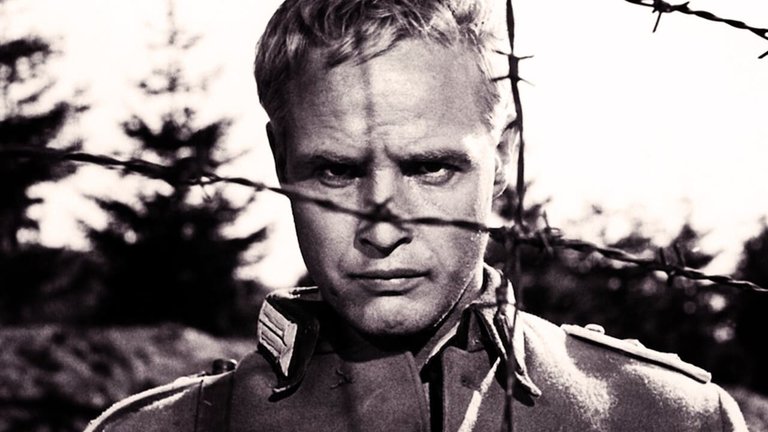Film Review: The Young Lions (1958)

There exists a notable distinction between something being "grand" and something being "bloated," a contrast that is particularly evident in the larger-than-life epics that Hollywood produced during the 1950s. Among these ambitious projects, The Young Lions, directed by Edward Dmytryk in 1958, stands out as a prime example of a film that, while striving for grandeur, ultimately succumbs to its own excesses. This war epic attempts to weave a complex narrative involving the experiences of three men during World War II.
The film is based on 1948 novel by Irwin Shaw, which is loosely based on the author's own experiences during the Second World War. The plot unfolds through the intertwined stories of three soldiers fighting on opposing sides of the conflict. The first character introduced is Christian Diestl, portrayed by Marlon Brando, ski instructor who attends New Year's Eve party in the Bavarian Alps in 1938. At this juncture, Germany is still at peace, and Diestl, though apolitical, reflects the sentiments of many Germans who believe that Hitler's regime is beneficial for the country. This perspective horrifies American socialite Margaret Freemantle, played by Barbara Rush, who has had a brief romantic liaison with him.
Few years later, Margaret is involved with Michael Whiteacre, a Broadway star played by Dean Martin, who is drafted into the US Army. At the recruitment office, he befriends Noah Ackerman, a shy Jewish shop clerk portrayed by Montgomery Clift. Their paths intertwine further when Ackerman meets Hope Plowman, a girl from rural Vermont, with whom he eventually marries, despite her father's initial resistance to a Jewish son-in-law. Both Ackerman and Whiteacre are assigned to the same unit, and although they experience separation, they are ultimately reunited during the last months of European campaign. Meanwhile, Diestl's journey Wehrmacht officer in occupied France and North African theatre leads him to question the Nazi regime and the purpose of the war, culminating in a convergence of all three stories in 1945 Germany.
Produced by 20th Century Fox, The Young Lions was an ambitious project with a substantial budget, and its epic nature is reinforced by the use of Cinemascope. The film's cinematography, handled by Joseph MacDonald, is presented in black-and-white, a choice that, while common for WWII films of the era, seems somewhat anachronistic given the availability of colour technology. This decision can be attributed to the public's established perception of the war, shaped largely by black-and-white documentary footage from the 1940s, as well as the practical necessity of integrating existing stock footage into the narrative. In this case, some of the documentary material was sourced from the Oscar-winning British film Desert Victory (1943).
The film's primary draw for audiences was undoubtedly its star-studded cast, featuring three prominent actors, two of whom were renowned for their Method acting techniques. Marlon Brando, in particular, delivers a standout performance as Diestl. Despite the questionable decision to dye his hair blonde to conform to Nazi Aryan stereotypes, Brando effectively embodies the character's internal struggle, demonstrating a remarkable command of the German accent. His portrayal captures the transformation of a man whose worldview shifts dramatically throughout the film, ultimately ending in a state of disillusionment, mirroring the fate of his country. Brando's investment in the role was so profound that he named his son Christian after his character.
In contrast, Montgomery Clift's performance, while intense, does not quite match the impact of Brando's. This disparity can be attributed to several factors, including script issues and Clift's personal struggles following a devastating car accident that aged him prematurely. His character, Noah Ackerman, is portrayed with sensitivity, yet the depth of his performance is somewhat diminished in comparison to Brando's commanding presence. Clift's tumultuous personal life, marked by substance abuse, further complicates his portrayal, leaving audiences with a sense of unfulfilled potential.
Dean Martin, primarily known as a light entertainer at the time, uses his role as Whiteacre to break free from the shadow of his partnership with Jerry Lewis and demonstrate his capacity for serious drama. Although his performance is solid, aided by coaching from Clift, the character of Whiteacre lacks sufficient screen time to make a significant impact within the overarching narrative.
The supporting cast features several notable European actors, among whom Maximilian Schell stands out as Captain Hardenburg, Diestl's ruthless superior. Schell's portrayal adds depth to the film, yet his success in Hollywood contrasts with the limited recognition afforded to many of the other European actors involved.
The screenplay, penned by Edward Anhalt, remains largely faithful to Shaw's novel, which contributes to the film's episodic structure. This format, while allowing for a variety of vignettes, results in a narrative that lacks cohesion, with some segments proving more compelling than others. A particularly powerful scene occurs near the film's conclusion in a recently liberated concentration camp, yet viewers must endure a considerable amount of lacklustre material that contributes to the film's nearly three-hour runtime.
Irwin Shaw, during the film's production, found himself exiled from Hollywood due to alleged Communist sympathies and expressed dissatisfaction with the adaptation of his work. His primary grievance centred around the "softening" of Diestl's character, who was transformed from a Nazi sympathiser into a more ambiguous figure questioning the regime's ideologies. This alteration extended to the film's ending and the near-total removal of references to anti-Semitism within the United States and its armed forces.
Despite receiving mixed critical reviews, The Young Lions achieved commercial success at the box office. It opened at number two behind The Bridge on the River Kwai and grossed $4.48 million in rentals in the United States and Canada. However, contemporary cinephiles and film scholars often regard it as one of the less successful or significant Hollywood epics of its time.
RATING: 5/10 (++)
Blog in Croatian https://draxblog.com
Blog in English https://draxreview.wordpress.com/
InLeo blog https://inleo.io/@drax.leo
Hiveonboard: https://hiveonboard.com?ref=drax
Rising Star game: https://www.risingstargame.com?referrer=drax
1Inch: https://1inch.exchange/#/r/0x83823d8CCB74F828148258BB4457642124b1328e
BTC donations: 1EWxiMiP6iiG9rger3NuUSd6HByaxQWafG
ETH donations: 0xB305F144323b99e6f8b1d66f5D7DE78B498C32A7
BCH donations: qpvxw0jax79lhmvlgcldkzpqanf03r9cjv8y6gtmk9
Posted Using InLeo Alpha